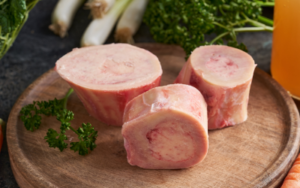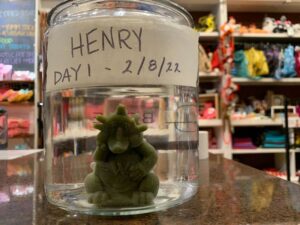Dogs in the Wild Didn’t Eat Dental Chews
Domesticated dogs are prone to gum disease and tooth decay just like people are. Their ancestors of course didn’t eat dental chews. But they didn’t eat kibble, milk bones or any other processed foods either. Dogs in the wild subsisted on a diet of raw, whole prey that in order to consume had to be chewed and pulverized. The combination of not only eating raw meaty tissue rich in enzymes, with a pH that naturally helps to retard plaque, but also by necessity chewing through sometimes fur and stringy, sinewy tissue (like flossing) or cartilage and bone (providing mechanical abrasion), amounted to a more than adequate natural oral care routine. And that is true for cats in the wild as well.
Domesticated pets need an approximation of that wild brushing and flossing effect to keep their gums and teeth healthy. Bacterial infections in the mouth can also easily travel to other parts of the body via the many blood vessels that are part of the gums, so the health of teeth and gums are important not just for clean breath, but for the overall health, and longevity, of our pets.
Do Dental Chews Really Work?
Honestly, we’re not really sure. There just isn’t a lot of data out there on dental chews. Many of our customers are loyal to them, but is it because they really reduce tartar or because dogs love them so much? Given the size of the pet oral care industry (estimated at $1,564 million for 2020 and growing), they ought to. Clearly a lot of research has gone into their design. There’s no doubt about the taste and chew appeal. As a part of the oral care solution, palatability matters. Because dogs love them, they will do their part (chewing!) enthusiastically…and cooperation isn’t something you can necessarily count on for other parts of your oral care plan. Dental chews are designed for maximum exposure to teeth and gums, and for longest possible chew time. While your dog happily licks and chews, all variety of bristles, bumps and grooves provide gum stimulation and scraping action against the teeth. Dental chews are intentionally ‘tacky’, grabbing onto and hopefully dislodging film on the surface of teeth. Depending on which you ‘chews’, ingredients like chlorophyll, cinnamon, turmeric, cloves and parsley may help minimize bacteria & inflammation, and stimulate fresh breath.
Whether they are effective, or not… don’t rely on dental chews alone to keep teeth clean. Why? For one, just like people, dogs often favor chewing on one side of the mouth or the other, which means only half the mouth is receiving full benefit. Two, even with all-natural ingredients, they are highly processed. But the most important reason is that your oral care routine will have exponentially greater impact if you approach the problem with from 360 degrees. Provide dental chews to tap into the natural desire to chew, add a dental powder to their food, put dental water additives in their drinking bowls daily to inhibit plaque and bio-film growth, get an oral care kit with a brush to thoroughly clean the teeth and gum line, and use “brushless” gels and sprays to minimize bacteria between brushing and chewing.
 And please include raw recreational and edible meaty bones. Raw meaty bones like these from Primal or Northwest Naturals are the original ‘dental chews’. They are whole foods, unprocessed, and rich in enzymes, collagen, and minerals. The pH helps the saliva to inhibit tartar growth, and your dogs prey drive means enthusiastic chewing and scraping, which will help to physically dislodge calculus. Beef marrow bones are very high in fat, but you can scrape out nearly all the marrow and it will still provide hours of engaged chewing. Buffalo is a much leaner alternative, and considered sweeter and softer, so a great choice for older dogs with sensitive teeth, or any dog with food sensitivities. As with all chews, select the appropriate size (bigger than they can fit in their mouths…rule of thumb, ‘as big as their head’) and monitor as they chew/remove if it becomes too small, or breaks into pieces.
And please include raw recreational and edible meaty bones. Raw meaty bones like these from Primal or Northwest Naturals are the original ‘dental chews’. They are whole foods, unprocessed, and rich in enzymes, collagen, and minerals. The pH helps the saliva to inhibit tartar growth, and your dogs prey drive means enthusiastic chewing and scraping, which will help to physically dislodge calculus. Beef marrow bones are very high in fat, but you can scrape out nearly all the marrow and it will still provide hours of engaged chewing. Buffalo is a much leaner alternative, and considered sweeter and softer, so a great choice for older dogs with sensitive teeth, or any dog with food sensitivities. As with all chews, select the appropriate size (bigger than they can fit in their mouths…rule of thumb, ‘as big as their head’) and monitor as they chew/remove if it becomes too small, or breaks into pieces.
Are dental chews safe and digestible?
Dental chews have evolved since the early 2000’s when first generation Greenies were causing blockages and other digestive problems. For healthy dogs, if provided with the appropriately-sized chew, plenty of fresh water, and monitoring, they are believed to be as safe as any other thing your dog will want to gnaw on….depending on who you talk to! What do we believe? Raw bones should be your first choice, but not everyone is open to ra w. Dental chews are a reasonable option as part of your routine, and may have a positive impact. Just remember that nothing replaces brushing, except perhaps consistently providing appropriately-chosen raw bones. If you are providing dental chews, alway
w. Dental chews are a reasonable option as part of your routine, and may have a positive impact. Just remember that nothing replaces brushing, except perhaps consistently providing appropriately-chosen raw bones. If you are providing dental chews, alway s look for natural ingredients that you easily recognize (and can pronounce). Avoid artificial dyes, preservatives (like BHA, not FDA-approved safe for people so your dog shouldn’t have it either) and ingredients like propylene glycol (petroleum derivative), carrageenan (inflammatory) and by-products. We prefer edibles to have simple ingredients panels, but with scientifically-engineered dental products that is not common. Our most popular chews are Missing Link Smartmouth Original Dental Chews and PlaqueOff Bacon chews.
s look for natural ingredients that you easily recognize (and can pronounce). Avoid artificial dyes, preservatives (like BHA, not FDA-approved safe for people so your dog shouldn’t have it either) and ingredients like propylene glycol (petroleum derivative), carrageenan (inflammatory) and by-products. We prefer edibles to have simple ingredients panels, but with scientifically-engineered dental products that is not common. Our most popular chews are Missing Link Smartmouth Original Dental Chews and PlaqueOff Bacon chews.
 But what about digestibility? It’s hard to say whether, once chewed into pieces and swallowed, the ingredients are being simply passed or digested. So we’re running our own (admittedly rudimentary) science project. What happens when you soak them in everyday water, and how long does it take for one to soften and eventually break down? Stay tuned for un update.
But what about digestibility? It’s hard to say whether, once chewed into pieces and swallowed, the ingredients are being simply passed or digested. So we’re running our own (admittedly rudimentary) science project. What happens when you soak them in everyday water, and how long does it take for one to soften and eventually break down? Stay tuned for un update.

